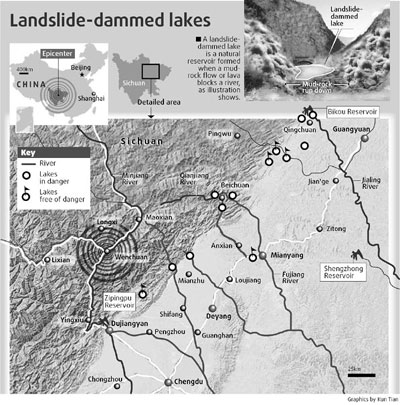Dams safe but risks remain: Official
By Guan Xiaofeng (China Daily)
Updated: 2008-05-21 07:53
Updated: 2008-05-21 07:53
Most of the lakes and damaged dams in Sichuan are currently safe but face the danger of heavy rain and aftershocks in the next few days.
Li Chengyun, vice-governor of Sichuan province, said at a press briefing on Monday that 21 lakes could breach their banks, and efforts are being made to reduce the risks.
The National Meteorological Bureau has forecast moderate or heavy rain - 13 to 30 mm - to hit the disaster areas in the next three days.

The Sichuan earthquake administration said there is still the possibility of severe aftershocks.
Xu Shuisen, an official with the Chengdu earthquake administration, told China Business News the government was aware of the danger of floods caused by lakes bursting their banks, and had taken steps to reduce the risks.
Two experts and soldiers have been assigned to each lake and dam to keep a 24-hour watch.
The government also has plans in hand to evacuate people downstream should the need arise. In some places, troops and construction teams have been deployed to divert the flow of water from the lakes and dams.
One lake that poses a threat is in Beichuan county. The lake was formed due a landslide that partially blocked the Qianjiang River. It is 40 m deep and contains about 30-40 million cu m of water.
In Qingchuan county, another lake has been formed containing about 10 million cu m of water. Experts with the Sichuan water resources department said the lake's water level was rising. All people living downstream have been evacuated.
Gao Jianguo, a researcher with the China Earthquake Administration's Institute of Geology, said it was extremely urgent to monitor the newly formed lakes that could burst their banks and cause flooding downstream.
"As the rainy season is approaching, these unstable lakes, or natural reservoirs, pose a serious threat to densely populated downstream areas," Gao said.
In 1933, three newly formed lakes burst their banks 45 days after an earthquake measuring 7.5 on the Richter scale struck Diexi in western Sichuan, he said.
Floods extended 250 km to Dujiangyan, killing 2,500 people.
Chai Hejun, a researcher with the Chongqing Institute of Transportation Design, said 21 percent of the new lakes could breach within a day, 48 percent within 10 days and 88 percent within a year.
Gu Junyuan, chief engineer with the State Electricity Regulatory Commission, said on Monday that all of the hydropower stations along the upper reaches of the Minjiang River, a major river running through the quake-hit areas, were "quite safe".
The hardest-hit area, which has 29 dams, is located in a valley in the upper reaches of the river, he said.
Most of the dams are solid gravity dams or gate dams, which are strong enough to sustain overflowing water.
Five hydropower stations where the earthquake's epicenter was located are relatively small, with a total storage of 1.5 million cu m.
"Even if there are some problems with these dams, we have the giant Zipingpu Reservoir downstream of the Minjiang River," Gu said.
"With a storage capacity of 1.1 billion cu m, it has the capacity to contain the runoff from some of the damaged dams."
The Zipingpu Reservoir is now operating properly after sustaining some minor damage during the earthquake, Gu said.
|
||
|
||
|
|
|
|